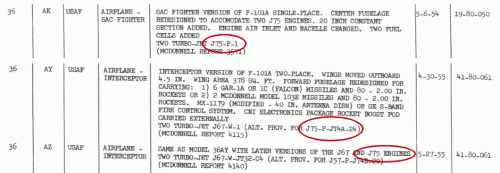Wow, has it really been a year since I posted this? :

I have continued scratching away at this so am posting what scant results are available for anyone interested.
The F-101B was approved in mid-1955, to be powered by advanced derivatives of the basic J57 engine. The primary track for engine development was undertaken by Pratt & Whitney. The ninth preproduction F-101A, 53-2426, was bailed to P&W and delivered to their facility at Edwards AFB on 22 Octiber 1955. At the time the aircraft was delivered, it retained its original J57-P-13 engines as well at they Type II inlet ducts that represented McDonnell's first attempt at addressing the compressor surge in the F-101A, which was quite severe with the original design. The engines would surge at full power settings immediately after takeoff or in any accelerated manuever over 1.5 G.
53-2426 was to be used for flight testing of advanced J57s for the F-101B, but at the time it was delivered the F-101A was still experiencing compressor surge. Indeed, throughout 1955 this was considered the major potential operational deficiency in the aircraft. While MAC continued work on refining both the inlet design and the geometry of the ducts leading to the engines, P&W initially concentrated on the powerplant to increase the surge boundary. The fixes to the basic engine proceded fairly quickly, although it took a great deal of time and effort on MAC's part to address the inlet duct issues. By December 1955, the surge boundary of the J57 had been improved to the point that, unbeknownst to pilots or MAC engineers alike, the F-101A began to run into the pitch-up boundary. Within a span of a few weeks from late December 1955 through mid-January 1956, Robet Little had enocuntered pitch-up at supersonic speed but recovered, Capt. John Dolan pitched up and rode in an F-101A near Edwards AFB, and Maj. Lonnie Moore pitched up on takeoff at Eglin AFB. As it turned out, there was little warning up through about Mach 0.95, and no warning whatsoever at supersonic speeds.
Initially, the F-101B was designed for the J57-P-45 engine, with the J57-P-35 as an interim fit. I have no evidence that the J57-P-35 was ever built or flown. Somewhere around early 1956, 53-2426 received the first of the developed engines, installed in the right engine bay. I have been unable to turn up specific records, but by all appearances this was the J57-P-45 engine. It looks as though it had a variable-flap ejector nozzle and, at least from P&W sources, was the first ever convergent-divergent turdojet nozzle flown and capable of producing over 17,000 pounds of thrust apiece. Unfortunately, I have no hard dates or other records to confirm this information, which is based on the recollections of a P&W test pilot. Apparently, at the time the news of the Fairey F.D.2 breaking the speed record reached the folks at Edwards, 53-2426 had been retrofitted with two C/D engines and during tests by P&W was routinely flying at speeds approaching Mach 2. Again, the record so far is extremely spotty but given G.E.'s experience with the variable ejector nozzle of the J79 in its early years, it is not surprising that this was abandoned for a fixed C/D nozzle design, the 57-P-55. This is what was flown on Project Firewall by Maj. Adrian Drew in December 1957, using P&W's development aircraft.
In the meantime, MAC was conducting its own tests using 53-2429 to test improved inlet ducts with a higher critical Mach number, the Type III inlet duct. By this time, a different interim engine for the F-101B was developed and flight tesgted on this aircraft by taking the existing J57-P-13 engine and modifying it with the afterburner developed for the J57-P-23 engine slated for prodcution examples of the F-102A. This yielded the J57-P-53 engine, tested on JF-101A 53-2426 and produced for F-101B aircraft 1-15 (not counting the NF-101A, 56-232.) These aircraft were built with a Type IIIb inlet that had been optimized for the J57-P-45 engine, but proved to be oversized for the production J57-P-55, leading to a slight but significant performance penatly for the F-101B. The inlet duct was simplified for more cost-efficient production to yield the Type IIIc, which is what was installed on most F-101B aircraft. As far as I can tell, both MAC and the USAF had decided to cut their developmental losses by this point and chose not to optimize the duct for the production "Dash-55" engine.
Anyway, for anyone interested, this is what I have come up with so far. I am thinking about a trip early next year to go through the P&W archives at the New England Air Museum to try to find more information.

